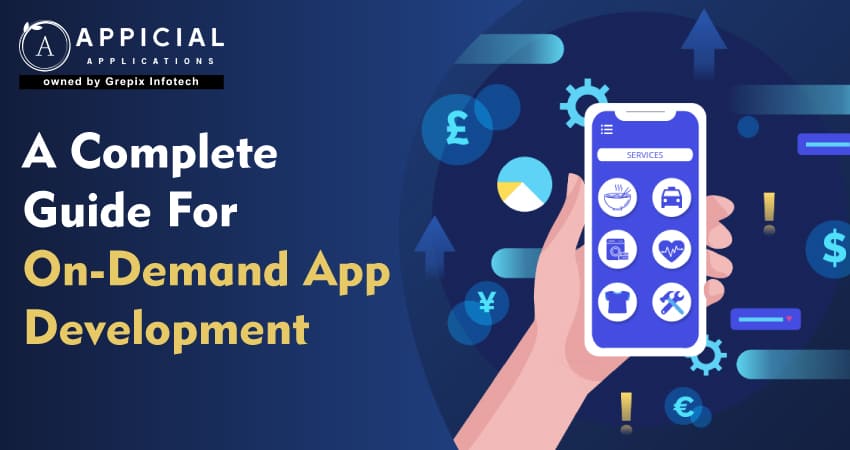
A Complete Guide For On-Demand App Development
An on-demand service app is the most versatile app that lets you order any of the available services online such as, food, medicines, etc. It adds value to the on-demand economy where goods and services are made available at the convenience of the customers. It can be developed by technological companies based on consumer behavior, cloud infrastructure, and many other interface layers connecting vendors, consumers, and logistic services.
An effective service that businesses can take advantage of and provide fast delivery of goods and services. On-demand app development needs sound network infrastructure and connectivity which integrates different verticals to track data and deliver goods and services on-demand. Technological industries are developing models that can benefit many industrial sectors to provide services on time with the use of technology.
For many sectors like groceries, retail, logistics, etc technology can be implemented on top of the existing models. The mobile commerce is an emerging technology which makes placing orders easy within a few clicks on the smartphone. Consumers can avail a host of services using these services and businesses can find better conversions and consumer satisfaction with the use of this technology.
Gain a complete understanding of on-demand app development with our comprehensive guide. This blog post covers the essential aspects, from ideation to deployment, providing valuable insights for entrepreneurs and businesses looking to enter the on-demand market. Whether you're considering transportation, food delivery, or other on-demand services, this guide offers a roadmap for successful app development.
Understanding On-Demand App Development
On-demand app development refers to the process of designing and building digital platforms that connect users instantly with service providers who can fulfill a specific need or request. These apps are built with the core principle of immediacy, which allows consumers to access goods or services at their convenience, often within minutes or hours.
This model has transformed traditional service delivery methods by digitizing and streamlining the customer experience. Instead of browsing directories, making phone calls, or visiting physical stores, users can now get what they need — from a ride to the airport to a plumber for a leaking tap all through a mobile or web-based application.On-demand apps are widely used across various industries, including:
- Transportation (e.g., Uber, Lyft)
- Food Delivery (e.g., DoorDash, Uber Eats)
- Healthcare (e.g., telemedicine, at-home nursing services)
- Home Services (e.g., TaskRabbit, Urban Company)
- Logistics & Delivery (e.g., Postmates, DHL On-Demand)
- Beauty and Wellness (e.g., at-home salon or spa appointments)
- Freelance and Gig Economy (e.g., Fiverr, Upwork)
Key Features of a Successful On-Demand Services App
To build a competitive on-demand services app, consider incorporating the following features:
- User-Friendly Interface: Ensure intuitive navigation for both users and service providers.
- Real-Time Tracking: Allow users to track service providers in real-time, enhancing transparency.
- In-App Communication: Facilitate seamless communication between users and providers through chat or call features.
- Ratings and Reviews: Implement a feedback system to maintain service quality and trust.
- Secure Payment Gateway Integration: Integrate reliable payment gateways to process transactions securely and efficiently.
- Push Notifications: Keep users informed about service updates, promotions, and other relevant information.
- Multi-Language and Currency Support: Cater to a diverse user base by supporting various languages and currencies.
A service provider company such as Uber are helping people get where they want using their app. The reach of on-demand service apps can be far-fetched and can help many industries build customers and better vendor management. This is the app that helps you satisfy targeted customers by satisfying their needs. These are the parameters and insights you can look into to develop an on-demand service app for providing services.
Choose the target audience
It could be people of different age groups, demographics, ethnicities. Choose a small or any size of the target audience and analyze what service they are looking for which makes their life easy. Analyze how your target audience would be benefitted by this service and how it is solving a problem.
Features for the app
Push notifications, vendor management, admin management, customer request service, ratings, tracking and managing reports, payments, and other services. You can develop a customized on-demand service app and choose the features you want to add depending on the type of service you are providing. You can develop client-delivery-booking apps.
Backend
You need a set of APIs that connect the app to various interfaces and come with a free or a paid subscription plan. APIs let you develop customized on-demand apps for smartphones. It lets you use a single system to manage vendors, admins, customers, reports, payments, and tracking orders. Using APIs reduces costs and makes the apps stable and sustainable.
Flexibility
If you are the service provider you can work on your timings and decide the schedule. You can track and analyze the reports as everything is accessible within a few clicks from the dashboard of the app. From the dashboard, you can manage and view various services, pricing, discounts, and more.
Testing
At different stages of development of the on-demand service app, it is important to test the app before you launch it. Test the app in a real-time environment to check for bugs, consistency, and features in beta testing before publicly releasing the app. You can reiterate the process of testing until there are no bugs or inconsistencies.
Launch
Once the app is tested for features, functionality, navigability, and other aspects, you can launch the app. You can launch the on-demand service app in the app stores. If for any reason, your app gets rejected you can rework and re-launch it.
There are many industries benefited with the on-demand service apps such as transportation, food delivery, retail, healthcare, and e-commerce industries. The payment system is easy to use, fast, and secure. Businesses can use these apps to satisfy their customers and provide them with quality service which can be booked within a few clicks. With these apps, services are made available 24x7 from any location making it convenient for customers to use them to satisfy their needs.
Monetization Strategies for On-Demand Apps
Developing a sustainable revenue model is crucial for the success of any on-demand app. Here are several monetization strategies commonly employed:
1 Commission-Based Model
This is one of the most prevalent models, where the platform charges a percentage fee for every transaction between the service provider and the customer. For instance, a TaskRabbit clone can deduct a commission from each task completed through the platform.
2 Subscription Plans
Offering subscription plans to users or service providers can ensure a steady revenue stream. Users might pay for premium features, while service providers could subscribe for enhanced visibility or access to more job opportunities.
3 Featured Listings and Advertisements
Service providers can pay to have their services featured prominently within the app, increasing their chances of being hired. Additionally, integrating advertisements can generate revenue, especially if the app has a large user base.
4 Surge Pricing
Implementing dynamic pricing during peak hours or high-demand periods can maximize profits. This strategy is commonly used in ride-hailing on-demand services apps.
5 In-App Purchases
Offering additional services or products within the app, such as expedited service or premium support, can encourage users to make in-app purchases.
6 Data Monetization
Aggregated and anonymized user data can provide valuable insights for third parties, offering another revenue stream. However, it's essential to handle data responsibly and comply with privacy regulations.
How to Scale and Enhance Your On-Demand App?
Once your on-demand app is launched, focusing on scalability and continuous improvement is vital to meet growing user demands and stay ahead of competitors.
1 Implementing Advanced Technologies
Incorporating technologies like Artificial Intelligence (AI) and Machine Learning (ML) can enhance user experience. For example, AI can provide personalized service recommendations, while ML algorithms can optimize task assignments in a TaskRabbit clone.
2 Expanding Service Offerings
Diversifying the range of services offered can attract a broader user base. For instance, a TaskRabbit clone can expand beyond home services to include wellness, tutoring, or event planning services.
3 Enhancing User Engagement
Introducing features like loyalty programs, referral bonuses, and gamification can increase user engagement and retention. Regularly updating the app with new features based on user feedback also keeps the platform relevant.
4 Strengthening Payment Gateway Integration
As the app scales, ensuring that the Payment Gateway Integration can handle increased transaction volumes securely and efficiently is crucial. Supporting multiple payment methods, including digital wallets and international currencies, can also enhance user convenience.
5 Optimizing Performance and Reliability
Regularly monitoring app performance and addressing any issues promptly ensures a seamless user experience. Implementing robust backend infrastructure and utilizing cloud services can aid in handling increased loads.
6 Expanding Geographical Reach
Scaling the app to new regions or countries can significantly increase the user base. However, it's essential to understand and adapt to local regulations, cultural nuances, and market demands.
Conclusion
The On-Demand App Development has revolutionized how businesses serve their customers. It is no secret that these on-demand service apps make it easier for customers to get what they want at their doorstep and for businesses to provide quick and efficient delivery of services. These are high-performance apps that boost the economy of any country.
They are based on scalability models, and businesses can seek potential growth in developing these apps. It is a cost-effective solution for branding and has a direct connection with consumers using your service. This is the business that attracts investors easily as it has a higher return-on-investment rate. These are the most time-saving and cost-effective solutions for businesses as well as consumers.
Looking out to start your own venture like UrbanClap? Try out our UrbanClap Clone App UrbanClap Clone, the easiest way to kick-start your taxi business.





